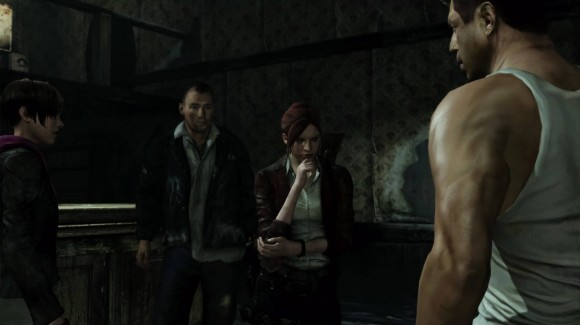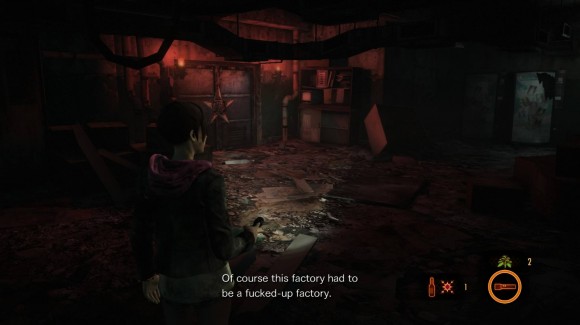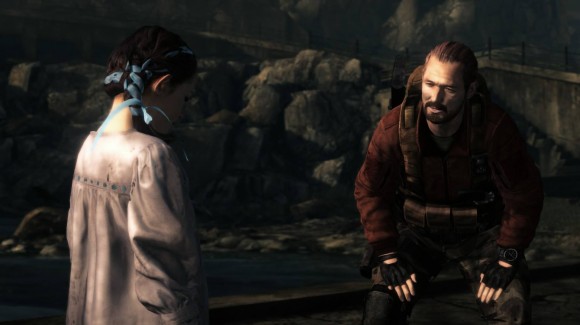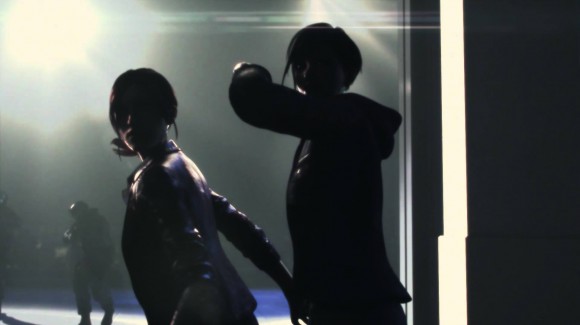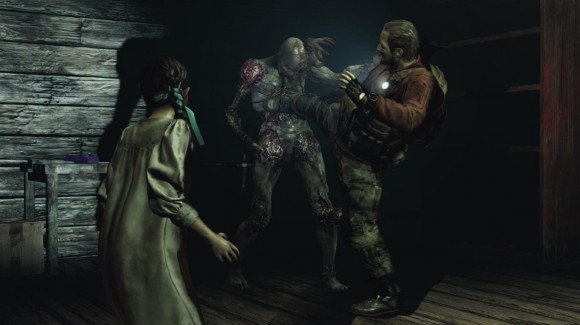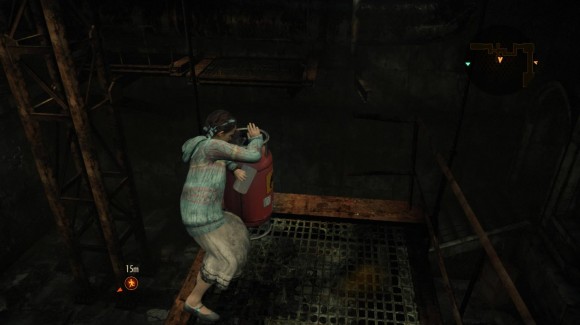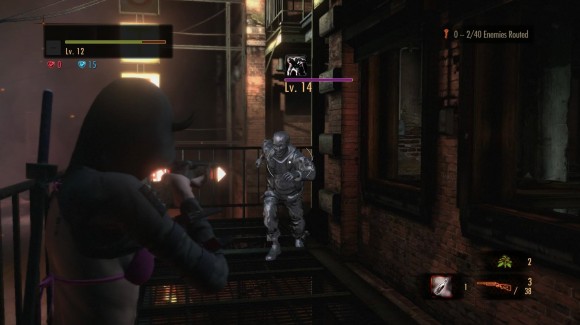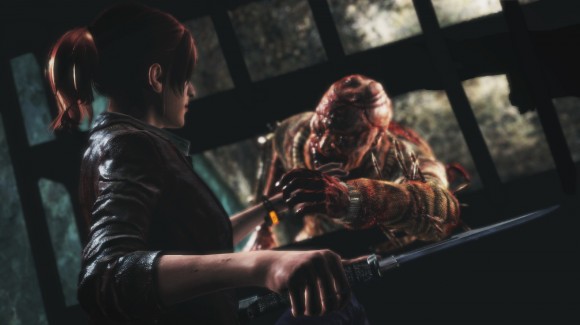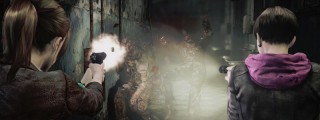And thus wraps up our four week journey of the macabre, having made it to the end of that Three Ladies and a Man adventure known as Resident Evil Revelations 2. It’s time to recap how it all stacks up and whether or not it’s worth diving into your wallet.
The first question that often comes to mind is “Why is this game episodic? Isn’t this Capcom just trying to squeeze you for more money?” Well, seeing as how the episodes line up to a total price of about 24 bucks, it doesn’t really feel like a cash in, no. Yes it’s another one of those tricky games where you kind of need a chart to figure out what version you want, and yes Capcom kept it a secret just what goodies would be in the $40 retail version, but it’s hard for me to see this as an abusive money grabbing exercise.
So why IS it episodic. Well, my guess is for two reasons. Revelations appears to be the continuation of a brand. The series was originally created so that it could be taken in bite sized doses on portable systems. While Revelations 2 is console only, I can understand wanting to continue the same style of delivery, if only in wanting to keep the “spirit” of their spin-off franchise. Second, I have to admit I looked forward to each installment week by week like I would a television series, and the game itself was pretty tongue in cheek about it with their “Previously” markers to recap the episode before it.
Finally, and probably most importantly, it’s a bit of a tone and gameplay issue. See, each episode plays just a little differently from the last. Episode 1 was about exploring an unfamiliar environment, getting your bearings, and figuring out the early mysteries. Episode 2 was a bit more action packed, a chase through a dead city complete with power tool wielding marauders and helicopter crashes. Episode 3 was heavily puzzle and trap based, with rooms lifted straight from a combination of heist movies and earlier Resident Evil games.
I think the episodic style allowed Capcom to be a bit more experimental with their approach to the game. It does kind of recall their failed experiment with Resident Evil 6, the ability to play multiple stories with different paces and tones, but it all comes together much, much smoother in Revelations 2.
Best part of Revelations 2 might be that it’s a game that’s not afraid to poke fun of itself or the earlier games in the franchise. From the early “I almost became a Claire sandwich”, to Claire later explaining a complicated door puzzle to Moira and the teenager remarking “That kind of makes sense, I don’t know how it does, but it does.” It fondly remembers Claire’s other romps, Resident Evil 2 and Code Veronica, with moments clearly influenced by those games. While the game had its moments of levity it also never lost sight of the fact it was survival horror, and once you got used to the mechanics of one area and its enemies, it would throw a wrench in the whole thing to take you off balance once again.
You’ll play two sets of protagonists in this title. Claire and Moira, then Barry and Natalia. As a rule of thumb Claire and Moira are more inventory management while Barry and Natalia are about surviving skirmishes. As a result, Claire and Moira will run into several enemies they can either ignore or engage, and tend to have far more puzzles to solve. Barry and Natalia meanwhile will have to down more enemies, and they’ll get more ammo to do so, but their mix of baddies tend to have a ton of nastier tricks and do more damage. There is a stealth mechanic in the game that, thankfully, works much better than it did in RE6, but by that same token the stealth in Revelations 2 felt a little overpowered.
The best way to compare the partner dynamic is with the bloodhound and the hunter. The bloodhound finds items, points out monsters, and can even stun them, while the hunter puts them down. It’s set up so you’ll no doubt be controlling the weaker of the two partners the majority of the time, which might be a problem for some, though in my case it aided in making me feel a bit more helpless and forced me to be more cautious in my actions.
Despite my earlier praises, and my love of her new, mature office lady design (gotta have an appreciation for aged wine folks) Claire got to be a bit too cardboard personality wise as the episodes continued. There is an emotional “peak” for her in the story that’s set up nicely, so stale acting might be the culprit in her case. In that same respect the character Moira (whose design I also loved) got to be much less annoying and far more likable as a protagonist. Barry and Natalia definitely had some of the better interactions overall, story-wise I think I generally enjoyed the plight of the two ladies more than I did the antics of the faux father and daughter, mechanics wise Barry and Natalia felt far more necessary to one another as a duo than Claire and Moira did in their dynamic. Suffice to say, the characters and their separate journeys left me with mixed feelings.
Now is a good time to mention Revelations 2 has a bit a dynamic system in terms of the actions of one set of protagonists impacting the travels of the next. RE6 had a similar system, only they addressed their crossovers with simply giving players different objectives. It’s a lot closer to being a watered down version of Resident Evil 2’s system, where playing as Claire first would change the outcome of Leon’s “B” storyline and vice versa. A great example in Revelations is a seemingly innocuous puzzle Claire solves at one point in her story, that does nothing for you at the time, allows Barry to obtain a special weapon later on.
The plot is, well, it’s a plot. I will say this, it is far more and quite thankfully toned down from the plots of Revelations and RE6. The writer and creative director of this title definitely showed a lot of restraint creatively that the series is in dire need of. Even if I can’t flat out praise all the plot twists or the story, I’m at least thankful for a Resident Evil that followed the rules of KISS. Keep It Simple Stupid. It also had a couple of surprising and satisfying twists reserved for its endgame, so that’s a bonus.
The enemies are some of the best I’ve seen in the Resident Evil franchise. With creative boss fights that will keep you on your toes, though arguably exciting bosses is one of the few things the franchise has kept intact. One of the best in-game mechanics concerns a few invisible enemies you’ll run into. Barry can’t sense them, aside from a few headaches and a bit of visual distortion when the enemy is in the area, leaving it up to the teensie Natalia to spot them with her sixth sense.
Now when I initially broke into Revelations 2, I wasn’t a big fan of the controls. They all felt a little “simplistic”, a bit loose and characters too light. Paired with a fixed camera while running, I was a bit offput. However the deeper in you go, the smoother the game seems to handle. There are vast improvements in the controls over Revelations and Resident Evil 5, and the ability to dodge is greatly improved from 6. If the series continues in this direction they might have a solid control scheme by Revelations 3, RE7 or (hopefully) a series reboot.
Revelations 2 is far from perfect however. There are a few straight faced, groan worthy moments through out the game, as there are in every Resident Evil since inception. The graphics as I mentioned in my preview of episode 1 leave a bit to be desired and there’s nothing particularly next gen or even that high grade last gen about them, it definitely looks like a budget title, especially when stacked up against the beautiful RE5 and 6. While I never ran into many game breaking bugs, I noticed the game would chug more and more the deeper I got into the content on Playstation 4. The story was also pretty hit and miss, with some writing slip ups that could take you out of the narrative full stop.
Finally, unlike advertised the game is not set entirely in a prison. It has a bit of the “forward momentum” of the later RE games so while you’ll be spending a bit of time in a few key locations such as a sewer, a bar or a factory, you shouldn’t expect to settle into any one mansion-esque or police department atmosphere for too long.
A checkpoint system, predictable boss placement and the more fragile partner’s ability to auto heal also meant this game didn’t have you in as much of a panic as most other survival horror titles might. If an instant death was guaranteed the game almost always saved your progress for you right before. This is probably a mixed blessing as a few bosses were bullet sponges and soaked up well past the appropriate damage threshold to be fun. One could argue having all your puzzle progress reset due to a forgotten save is annoying, and I for one was incredibly grateful the checkpoint system was better implemented than 6. It does go a bit against the grain of the genre to have such a large safety net cast under you in the form of a checkpoint system, so perhaps it would be best if the franchise straight up returned to save rooms.
As a final note of reservation buyers need to beware when thinking of the PC version. It’s been reported that it was rife with issues since launch including Capcom stating they’d be unable to support co-op play on PC, then double talking when a few dedicated hackers managed to get multiplayer working fine on their copies. There are also reports of framerate issues that still plague it as of writing this article. My experience on Playstation 4 was mostly fine save for some weird problems with episode updates, which Sony has since claimed are resolved. I haven’t personally seen any issues reported on Playstation 3 or Microsoft consoles.
Between episodes I had more of a chance to settle into Raid Mode. If you’re a fan of the previous Raid Mode and the Mercenaries, Chris’ campaign in RE6, or arcade shooters with Action RPG elements, then Raid Mode will definitely strike your fancy. How it works is this, you’re a blank homunculus that can take on the form of one of several characters introduced throughout the game. Each character comes with their own stats and special abilities, and you can unlock and level these skills as you tackle Raid’s various stages. In other words, Moira’s “build” allows you to master melee attacks and magnum skills, so you can build her up to the point she’ll be able to kneecap a monster with a crit from her mighty revolver, and finish it off with a roundhouse that does 9000 damage.
The higher you get in Raid Mode the better the weapons and parts for said weapons you uncover. The weapon parts are all fairly vanilla at first, the ability to load a gun slightly faster, the chance to have each bullet do a bit more damage, but the deeper you get into Raid Mode the more fun your loadout and abilities get to be. At one point I was able to rock a setup that allowed me to set enemies on fire and do greater damage to them while they burned, all the while healing myself. It does take a bit of grinding but like most RPGs it’s fun to see those numbers rise. Of course you’ll be offset with stronger and stronger enemies, each that can also spawn with a special ability such as electrifying you on touch or being the god damn Terminator T-800.
It’s hard to say where this title is going to land in Resident Evil history. It’s certainly not a classic like Resident Evil 2 or 4. It’s not even a sub-classic like Nemesis or the REmake. By that same respect I can say it’s much, much better than the worst Capcom has had to offer from the franchise, and is a fairly respectable entry on its own even if it is rife with problems. I certainly enjoyed it far more on the whole than I did 6 for example. If you’re a fan of Resident Evil and if you miss yourself some Claire, this is a worthy title to pick up. It most definitely is worth hours of fun, if not for the main episodes then definitely for the Raid Mode.


